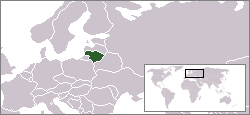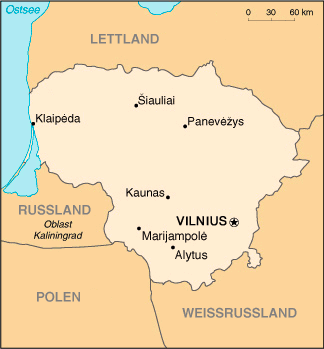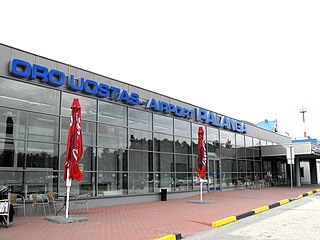| location | |
 | |
| flag | |
 | |
| Short dates | |
| Capital | Vilnius |
|---|---|
| Form of government | Parliamentary democracy |
| currency | Euro |
| surface | 65,200 km² |
| population | 2.849 million |
| languages | Lithuanian |
| Religions | Roman Catholic (majority) |
| power grid | 220 V / 50 Hz |
| Phone code | 370 |
| Internet TLD | .lt |
| Time zone | ME (S) Z 1h (OE [S] Z) |
Lithuania is a state in Baltic states (Central Europe). It borders in the north Latvia, in the east Belarus, in the south Poland (Voivodeships Podlaskie and across the four-country corner Warmia-Masuria) and in the southwest to the Russian exclave Kaliningradskaya Oblast.
Regions

Similar to in Latvia There are also four to five historical regions in Lithuania, depending on the counting method, which differ not only in terms of landscape but also in terms of tradition and dialect:
- Aukštaitija (Upper Lithuania), the largest region in terms of area in the northeast up to the capital Vilnius.
- Žemaitija (Lower Lithuania (Samogitia))
- Suvalkija in the southwest.
- Dzūkija in the south East.
- Mažoji Lietuva (literally Little Lithuania), the former Memelland, which is part of the Žemaitija during the Soviet era and sometimes still today. In contrast, the other four regions are grouped together as Didžoji Lietuva (literally Greater Lithuania) designated.
Cities

- Vilnius (German Vilna) - The capital
- Kaunas (German Chew, Polish Kovno) - the second largest city in the country
- Klaipeda (earlier Memel) - the only port in Lithuania on the Baltic coast
- Šiauliai (German Schaulen) - the fourth largest city in Lithuania in the north of the country
- Panevėžys (
 listen; German: Ponewiesch;) is a large city in northern Lithuania - around 130 kilometers away between the two state capitals Riga (Latvia) and Vilnius (Lithuania).
listen; German: Ponewiesch;) is a large city in northern Lithuania - around 130 kilometers away between the two state capitals Riga (Latvia) and Vilnius (Lithuania). - Nida (German Nidden) - a small town on the Curonian Spit
- Telšiai (žemaiticTelšē) is a small town with a lake and a two-story church.
- Jonava (German Janau) - a small town on the Neris
Other goals
The most famous landscape is that Curonian Spitwhich partly belong to Lithuania, partly to the Russian exclave Kaliningrad belongs.
Another attractive landscape is that Aukštaitija National Park in the northeast of the country.
background
getting there
Entry requirements
Citizens of the European Union only need an identity card. Lithuania has been a member of the Schengen Agreement since December 21, 2007. This eliminates the border controls EU member states.
By plane
To the 1 Vilnius airport(IATA: VNO) there are direct flights from Berlin, Düsseldorf, Frankfurt, Hamburg, Munich and Vienna. Ryanair flies from Frankfurt-Hahn to Vilnius.
To the 2 Palanga airport(IATA: PLQ), especially the seaside resort Palanga there are connections from Berlin, Frankfurt am Main, Hamburg, Hanover, Cologne and Munich in the summer months.
Ryanair and Wizz Air fly to the from England and Ireland 3 Kaunas Airport(IATA: KUN)There are flight connections from Bristol, London Luton and Dublin to Kaunas, among others.
By train
Poland: Since June 2016 there are again direct train connections to Lithuania (Białystok - Kaunas), but only on weekends. There is no need to change trains in Šeštokai, as the route has been switched to standard gauge. For connections via Minsk (see below) a transit visa 20 € (30 € for 2 transits - as of 2014) is required.
Belarus: There are several trains daily from Vilnius to Minsk and beyond to Ukraine and Russia. The previous connection to Grodno (Warsaw - St. Petersburg line) has been interrupted and is no longer passable.
Russia: Several corridor trains between Russia and the Russian exclave Kaliningrad operate daily via Vilnius. Of Vilnius there are 1-3 trains to daily Moscow and 1-2 moves after St. Petersburg.
Latvia: There is a daily connection from Vilnius to Riga above Šiauliai, however, it is very slow.
By bus
Long-distance buses are a cornerstone of the Lithuanian transport infrastructure. International companies like Eurolines, Lux-Express or Ecolines offer various daily bus connections from all neighboring countries and Western Europe to Lithuania. Important national providers are e.g. Kautra or Busturas. Together with numerous smaller providers and microbuses, they ensure easy access to the country's localities.
In the street
Arrival by car via the Polish-Lithuanian border crossings Ogrodniki-Lazdijai and Szypliszki-Kalvarija is possible without any problems. Since both states belong to the Schengen area, there are no border controls. Entry through the area of Kaliningrad is usually less useful, as citizens of most European countries need a transit visa for this.
By boat
Comprehensive sources of information about all ferry lines and detailed descriptions of the ships to Lithuania as well as booking options and tips for arriving by ship are provided by Ferrylines.com or DFDSLisco.com, both portals for ferries to Lithuania. From Germany connections are made by Kiel to the 4 Klaipeda ferry port offered.
mobility
Public transportation
The main public transport is the bus. There is a dense network both in the cities and across the country. A helpful portal for finding and booking suitable bus connections between cities within Lithuania and partly to neighboring countries is Autobusubilietai.lt.
There are few railway lines and many of them are in poor condition. However, the Vilnius-Kaunas railway line is very well developed and it only takes around an hour to get there. You can easily search for train connections and buy tickets via the Lithuanian Railways website (not in German, but also in English). There is no rail transport in town (apart from the airport shuttle in Vilnius), but there are trolleybuses.
Attention with the line numbers in city traffic: The same number can be used up to three times: for a trolleybus line, a normal bus line and a minibus line. The minibuses (Maršrutinis taksi) travel a fixed route, but have no fixed stops. You wave them to get in and let them know. Payment is made there in cash. Other city buses have tickets that you put in a validator. You can buy them at the kiosk or (more expensive, but still cheap for Western Europeans) from the driver. In the case of intercity buses, you usually pay the driver, but at the large bus stations you have to buy a ticket at the counter for some lines. The timetables at the intermediate stops in the country are only guidelines, the bus can also leave earlier.
Out and about by car / bike
In terms of population density, Lithuania has a high accident rate compared to other EU countries. This means that you have to reckon with (alcohol) controls by the police at any time of the day or night. The alcohol limit is 0.4 (driving license less than two years 0.2; drivers of motorcycles, trucks, buses (more than 9 seats): 0.0).
Due to the low population / car density, the probability of actually being involved in an accident is, however, rather low.
Lithuania has a well-developed network of trunk roads. The following rules for speed limits apply (unfortunately, rules published elsewhere are not always correct!):


Drivers (including foreign ones) who have had their driving license for less than 2 years must mark their vehicle with a sticker in the form of a maple leaf on the rear; For this group of people, in contrast to the table above, the maximum speed on motorways and expressways of 90 km / h and on country roads of 70 km / h applies.
Buses and trucks (including vans under 3.5 t) must purchase a vignette for highways (Fee overview).
Smaller places can usually only be reached via gravel roads; Road maps published in Lithuania also show this. With the car you can get around there well, but less quickly, they are not really suitable for cyclists.
Regardless of the actual weather conditions, winter tires are mandatory for all vehicles from November 10th to April 1st.
Caution: branches lying on the street can indicate that a manhole cover is missing there!
Helmets are mandatory for motorcyclists. Important note for cyclists: It is mandatory to use safety vests! Bicycle helmets are compulsory for children and young people under the age of 18.
Details can be found in the travel advice of the Foreign Office (see list of links) or those of the automobile clubs.
language
Lithuanian is a Baltic language that is only more closely related to Latvian. In some places there is a significant Russian minority; in places of interest to tourists, especially in Vilnius and Klaipėda. There is also a Polish minority in Vilnius and the region south of it.
You can usually communicate in English with the younger generation and in hotels and the like. In the middle and older generation (born before around 1970), English skills are much less common. As a rule, these people speak Russian more or less well. It is helpful to ask the question about knowledge of Russian in Lithuanian ("Ar Jūs kàlbate rùsiškai?") In order to overcome the aversion to the former occupation language.
In contrast, knowledge of German is much less widespread, but German-speaking people are also to be found. This does not apply to the Curonian Spit and Klaipėda (German Memel). Since this area used to be part of Germany, you are prepared for German tourists there.
to buy
Lithuania has been part of the euro area since January 1, 2015. The supply at the ATM is unproblematic. Many shops, even in smaller towns, also accept credit cards.
kitchen

The Lithuanian national dish are Cepelinai, Zeppelin shaped dumplings with meat filling. You can find restaurants with traditional fare (which are naturally related to neighboring countries) as well as international offers such as fast food chains.
nightlife
There are numerous bars, pubs and discos in the larger cities. It should be noted that discos do not fill up until midnight. However, there is no curfew and so the nightclubs are often open until 5 a.m. or even longer. The entrance fees are usually between 0 and 5 euros. In the big cities, like Vilnius and Kaunas, you can find clubs of different styles of music (electronic, pop / mainstream, Latin, ...). In discos, spirits and long drinks are more popular than beer and cocktails. In bars and pubs, on the other hand, beer is often the first choice. Most of the time, snacks and simple dishes are also served here.
The practice and use of prostitution, as well as sexual coercion, are punishable by law. If minors are involved in these crimes, this has an aggravating effect on the sentence; Police actions and controls must therefore be expected at all times.
Palanga is probably the most popular Baltic Sea destination par excellence in Lithuania during the summer months. Many young Lithuanians go here to party. Live music is often played in the pubs, ranging from traditional songs to pop music.
accommodation
public holidays
| Next appointment | Surname | importance |
|---|---|---|
| Saturday 1st January 2022 | Naujieji metai | New Year |
| Wednesday February 16, 2022 | Lietuvos valstybės atkūrimo diena | Independence Day (1918) |
| Friday March 11, 2022 | Lietuvos nepriklausomybės atkūrimo diena | Independence day |
| Sunday April 17th 2022 | Velykos | Easter Sunday |
| Monday April 18, 2022 | Velykos | Easter Monday |
| Saturday 1st May 2021 | Tarptautinė darbo diena | Labor Day |
| Thursday June 24th 2021 | Joninės | St. John's Day |
| Tuesday 6th July 2021 | Valstybės diena | Coronation of King Mindaugas |
| Sunday 15th August 2021 | Žolinė | Assumption Day |
| Monday 1st November 2021 | Visų šventųjų diena | All Saints Day |
| Friday December 24th 2021 | Šv. Kūčios | Christmas eve |
| Saturday 25 December 2021 | Šv. Kalėdos | 1st Christmas Day |
| Sunday 26 December 2021 | Šv. Kalėdos | 2nd Christmas Day |
security
General emergency number: 112
respect
Lithuanians orientate themselves strongly to the west and therefore also meet western tourists very openly and respectfully.
Post and Telecommunications
Telephone prefixes
Abroad: The country code must be prefixed with 310. In the mobile area, the international dialing code, e.g. for Germany 49, can be used.
Domestic long-distance calls: The number must be preceded by an 8 (not 0!), Which is often not written. Lithuanian cell phone numbers all start with 6.
The Lithuanian cellular network (telephone and internet) is very well developed, even in rural areas and in the forest there are seldom dead spots. Network operators are Omnitel, Please and Tele 2. Prepaid mobile communications types can be purchased in supermarkets, petrol stations and telephone shops without registration formalities.
Other special features
WC
The traditional toilet symbols are stylized in a very idiosyncratic manner, especially when it comes to the men's toilets. In the meantime you can often find the symbols like in this country, but also new signage such as in the recently renovated Kaunas train station sometimes use the traditional representation.

literature
- Lithuania: tourist map, (48 x 62 cm), Vilnius 2004 (Lithuanian Tourism Fund); 4 town square on d. Back: Vilnius, Klaipėda, Kaunas, Šiauliai; ISBN 9955954841
- Hamel, Christine; Baltic states: Estonia, Latvia, Lithuania; Cityscapes, castles, beaches, national parks, festivals, museums, hotels, restaurants; Munich 2015 (ADAC travel guide); ISBN 9783956891731
- Ilg, Reinhard; Freyer, Ralf; Trip through Lithuania; Würzburg 2006 (Stürtz); ISBN 9783800317301
- Plath, Thoralf; Lithuania, Curonian Spit; Ostfildern ³2009; ISBN 9783829704762
Web links
- https://www.lietuva.lt/en/ (en) - Official website of Lithuania
- Official Lithuanian Tourism Bureau
- Information from the Federal Foreign Office
- DFDS LISCO - Ferries to Klaipeda
- BaltiCCycle.eu - project on cycling in Lithuania, Latvia, Estonia with a lot of background information
- Accommodation in Dzukija National Park



